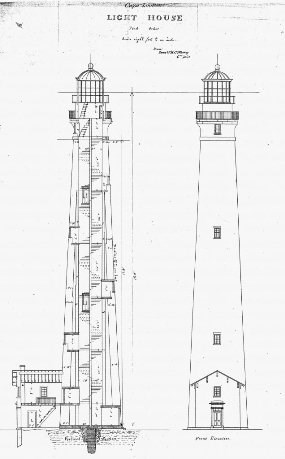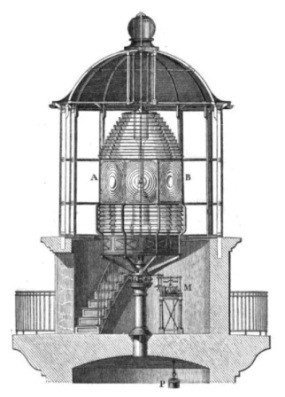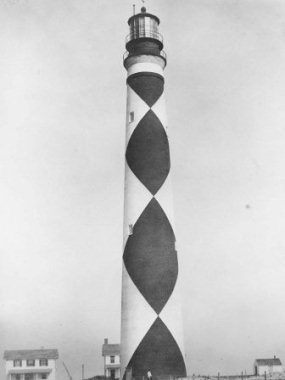|
Shortly after it was completed, it became apparent that the1812 Cape Lookout Lighthouse was ineffective. Almost half a century later--following administrative and policy changes in the Light House Board--the second Cape Lookout Lighthouse was completed. This new, taller tower was better suited to warn mariners of the dangers of Lookout Shoals. 
The New LightThe second Cape Lookout Lighthouse, completed and lit on November 1, 1859, replaced the shorter 1812 lighthouse. The double wall structure--the first of its kind in North Carolina--allowed the tower to be much taller than previous designs. The first order Fresnel (pronounced Frey-nel) lens was installed in the new tower. The 1859 lighthouse was 163 feet tall and its light reached approximately 15 miles out to sea. Shortly after the improved tower was activated, however, war broke out between the states. The light was extinguished to prevent Union ships from using it to navigate the treacherous North Carolina coast. The light was reestablished with a third order Fresnel lens in 1863 and shone for most of the remainder of the war. For more information, visit the Cape Lookout Light and the Civil War webpage. The original Fresnel lens was sent to France for repairs following the war and was reinstalled in 1867. The iron staircase, damaged in a Confederate raid, was also repaired that year. 
Lamps, Oil, and ElectricityWhale oil was used initially to power the lamp. Due to rising costs, the Light House Board switched to using mineral oil (kerosene) in 1873. The wick lamp was replaced by an incandescent oil vapor (IOV) lamp in 1912, increasing the visibility to 19 miles. Generators supplied electricity for the new electric lights installed in 1933. With electricity, Keepers no longer had to climb to the top to light a lamp, but still had to be there to monitor the generators and keep them fueled. The era of Lighthouse Keepers at Cape Lookout Lighthouse came to an end in 1950 when the light was automated: new technology allowed the light to turn itself on and off automatically. Generators were still producing the electricity needed to run the lighthouse but the job of overseeing them now fell to the men stationed at the Cape Lookout U.S. Coast Guard Station. In 1975, after 116 years of service, the Fresnel lens was replaced by two aero-beacons. The lighthouse continued to use generators for electricity until an underwater cable from Harkers Island was laid in 1983. At that time, the Cape Lookout Light Station was decommissioned and responsibility for the lighthouse was transferred to the U.S. Coast Guard Station at Fort Macon. On July 14, 2003, the Coast Guard transferred the tower and remaining property to the National Park Service in order to allow the lighthouse to be opened for public climbs. The light itself is still maintained by the U.S. Coast Guard. 
Courtesy of John Willis Daymarks and Flash PatternsWhen it was first built in 1859, the second lighthouse was a simple red brick tower as was the Cape Hatteras Lighthouse (1870), the Bodie Island Lighthouse (1872), and the Currituck Beach Lighthouse (1875). The Light House Board decided that each coastal lights would be assigned its own distinctive daymark, or color pattern. This would allow mariners to determine their location during the day in the same way that light flash patterns did at night. In 1873, the Cape Lookout lighthouse was painted with its distinctive black-and-white diagonal checkers (or "diamonds"). The original light was steady with no flash pattern. In 1914, however, the light changed from a "fixed white" to a "flashing" light when an occulting device, driven by a clockwork mechanism, was installed. The light pattern went to three 9 second flashes of light, then one 9 second flash of light, twice every ninety seconds as the solid panels of the occulting device passed in front of the light. With the installation of electric lamps in 1933, the light could actually flash as the bulbs could be turned on and off. The light flash pattern changed to on for 2 seconds, off for 2 seconds, on for 2 seconds, and off for 9 seconds. Today, the light "flashes" once every 15 seconds as the two aero-beacons rotate. |
Last updated: October 20, 2023
